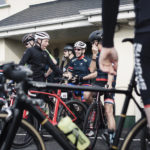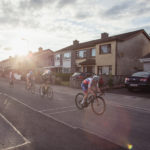(An amateur’s ode to winter training in the lull before it should start)
To help kick-start the winter training period after the 2012 racing season, the Galway Bay cycling club organized to have one of the top Irish cyclists of his generation, David O’ Loughlin from Cong, Mayo, to go through some of the nutrition principles and training techniques that have worked for him during his time as a pro.
Three Irish National Road titles, two National TT championships, a national Crit championship, three Rás stages, the Rás mountains jersey, national track records, the first Irish UCI track medal, one day classics such as the Shay Elliot, and the Olympic games… David has shown a remarkable ability to train hard and perform at peak levels when it matters; turning on enough power to leave all but the top tier in his wake.
Rather than go through all of the fine points and details, I’ve gone all decimal and tried to put what I picked up on the day into a list of ten. They come with no extended warranty or guarantee of success but they make sense to me.
1: No Pain, No Gain: Consistency is King.
This principle resounded in everything David was going through. There is no magic formula (no interest in discussing the drugs war here). You can’t expect results without the proper preparation and training. You can’t just show up at a race and compete against seasoned riders with good form without serious effort and commitment. Neither can you cram your training into a few weeks and expect results. It takes consistent work to build your strength, power, and speed. It won’t happen by accident or all at once.
2: Work on your Weaknesses
It is rare for a race to finish on a steep incline, especially in Ireland. It is rare for it to be completely flat either, or to finish with the starting bunch still intact. The specialists need to survive even where conditions don’t suit them. A sprinter has to get over the hills; a climber has to outsprint the other goats at the summit; a breakaway specialist has to have a kick to get clear after 50km off the front. Don’t just use the winter months to improve the style of riding that you feel you are best at. Target your weaknesses. If you are a climber build strength by adding sprints to your ride. If you struggle in the hills add hill repeats and hill intervals.
3: Train with Purpose; Fail to Prepare- Prepare to Fail.
If you set out on each training tide with only a vague notion of what you want to work on, you will only get inconsistent results. Decide in advance- today I want to do hill repeats; tomorrow I will do 30 minutes of zone 3 work. Hmmmm, it’s lashing rain… Ok, I’ll do those intervals on the turbo and 40 minutes of core work. Otherwise you will slip into the following habits: do 30 minutes easy to warm up, go hard going over the top of a climb then rest on the descent, stop looking at your heart rate, get bored and cycle along the prom in Salthill to see if there are any girls sunbathing. No? Oh, it’s winter, or a typical Irish summer. Maybe cycle through the city centre to see if anything entertaining is happening or work on your traffic light track stands. Or instead spend two hours daydreaming about hammering up the Alpe d’hUez in the big ring to take the yellow jersey by over 5 minutes, finishing on your own after emerging from the clouds, when in reality you’re freewheeling along at 23kph with a tailwind.
Granted, daydreaming (goal visualization with a dose of optimism) and enjoying the view (try a three hour turbo spin) are vital parts of your routine, but get the hard stuff done, tick off the session’s aim, and do some easy scenic miles with the satisfaction of sore legs.
Some of the intervals that David went through with us on the day:
- Hill efforts: 20 seconds max effort- 40 seconds at 70%, repeat; increase max effort time gradually
- Sprinting: On a group ride drop 50-100m off the back, come almost to a halt, then sprint to the front. Do a few of these even on an endurance ride.
- Over Geared sprints: Sprint in a big gear- the 52 * 11 or close to it. Low cadence, lots of power per stroke. Power workout.
- Power climbing: Do hill repeats in a big gear, in the saddle, focusing on pedaling in circles while keeping good posture. No bouncing, heaving, or head nodding!
- Peak power: Sprint repeats with high cadence- move your legs as fast as they will go.
- Team Time trial: Split a group into two, separate by 30 seconds and practice team time trialing. Switch riders in each team to try and keep them balanced. No rider can be dropped, but stronger riders can do longer pulls
- Zone 3 Intervals: At 80% (of peak HR or power), just under your lactate threshold. Start at 10 or 15 minutes and increase the time gradually. This is equivalent to a fast moving bunch.
- Crosstrain: Running and mountain biking are good ways to keep fit without feeling jaded from repetition. Be careful with running and begin at a slow pace- injuries are easily acquired, especially if you start running sub-40 minute 10km distances without stretching, in a pair of ten-year-old shoes that were growing mold in the shed for the last three years. At the very least don’t run in shoes with cleats.
4: Set Specific Goals
Following on from training with purpose is training with specific goals. Not the ones from the daydreams, but real achievable goals that will get you through the winter weeks when it seems that everyone around you is wearing several sweaters and gorging on mince pies with mulled wine while watching box-sets of HBO shows every night for 3 months.
Set goals and work backwards. Take time to plan. You don’t have to even set out to win, maybe aim to be able to finish in the bunch in a competitive league or finish a sportive ahead of guys that beat you last time round. Of course, it has to be a proper challenge. Easy goals= easy training= unrealized potential.
5: Measure your Efforts
Apparently, people trying to lose weight by dieting will eat less if they write down everything that they do eat. The very act of measuring improves performance! But hang on, don’t pull the trigger on the SRM and Garmin just yet- think about your needs first. There are different things and ways to measure, for example:
- “I felt my effort intensity was about 7/10 and my legs felt about 5/10”
- “I did 1:30 steady and 00:30 hard”
- “I did 00:40 between 150 and 160 BPM”
- “I did 3 * 10 of cadence at 115 rpm”
- “I did 2:00 with an average of 159 HR and 286 Watts, climbing 300 metres in 19 C weather with a NNW wind of 4 knots”
It’s possible that you need the latest power sensors to reach a new level of fitness, but most cyclists don’t need that much detail. A subjective post-ride mark-out-of-ten for a few key factors might be a start. Keeping track of time spent on the bike is a definite plus, and a heart rate monitor can help you see and control your effort on rides, especially when you know your zones and threshold level. Speed however, is not a good guide to your development as it is too dependent on conditions (road surface, inclines, wind, size of a group). Distance is likewise not the best measure. Time and intensity (HR monitor, power meter) are the ones to watch.
One way a device with a decent display helps is by giving you something to focus on during a solo ride. If you know your zones then you can work on using a more structured training routine based on them.
Why is a power meter better than a heart rate monitor? Consider, for example, a coach comparing two athletes- their hearts are not identical and will be different sizes and beat at different speeds for a given effort. The same heart will also beat faster or slower depending on the size of the hangover, the length of yesterday’s spin, or the number of cups of coffee you just drank. Power on the other hand eliminates the differences and allows for proper comparison. How many watts and for how long? It is a much more objective standard of effort measurement. For professional athletes or amateurs with professional attitudes then a power meter is great. If they become as cheap as heart rate monitors or my pockets deepen and wallet fattens up then I will buy one.
6: Eat Real Food
David’s take on nutrition is to stick to the basics and eat real food. Whenever you see a new product that supposedly offers huge benefits, ask yourself if someone is trying to sell it to you. Sports nutrition is a big industry; an industry that doesn’t particularly want everyone to suddenly decide that bananas, small sandwiches, boiled potatoes sprinkled with salt, or rice cakes with chocolate chips are pretty damn good to stuff your pockets with.
- Eat what you need: you need a lot less if you are trundling along in a slow bunch than when you are pushing hard in a break. Ironically it is much easier to eat in a bunch than in a fast break, so it is very important to remember that you need to keep topping up
- Drink enough. Measure yourself before and after a long ride. Any weight lost is mostly water. Becoming dehydrated is not good. Remember that in hot conditions you need a lot more liquid. Also, the fastest way to get your energy is through a liquid source, so a carbohydrate mixture is a good idea. Just don’t wait until an important event to start using it.
- Get recovery food in quickly: A glass of skimmed milk and a banana will do nicely. Chocolate milk is all the rage, and of course there are plenty of expensive protein products.
7: Take Care of your Core
Core training is a part of practically every sport, and it makes sense, given that the abdominal area is the point about which the rest of the body levers. The core muscles are constantly being engaged (and are the first muscles to switch on for most body movements- what muscle moves first when you raise your arm?) and need to be in good condition to keep proper form and posture. The off season allows you to focus on it a bit more and spend time making it stronger for the next season. There are lots of core workouts online- cruches, planks, leg raises, etc. Integrate a short workout into your routine. This is a case of the ‘easy’ being ‘hard’. It is hard because it is easy to skip, miss, or neglect. It is normally considered a separate, extra effort outside of regular training. It shouldn’t be.
8: From Strength to Strength
Another off-the-bike focus is building strength, for example using a gym routine, or a home workout using a swiss ball, dumbells, a medicine ball, etc. Again the off season is the time to do it, and general advice would include:
- Focus on cycling-specific muscles. Big guns might look good but are mostly extra weight on a bike.
- Maintain good form: Get an experienced instructor to watch you and show you how to do things right, especially when it comes to back position.
- Build up weight/resistance gradually and progressively make it harder
9: Train with a Team
You will cycle harder and faster with others, and an hour or two will pass much quicker than it would on your own. For sanity, morale, camaraderie and to practice skills such as bunch riding, hiding behind the biggest rider, hanging on to the fastest wheel, doing smooth turns on the front, and maintaining a conversation when you can only hear 20% of what a person says, a regular group ride is a must.
10: Enjoy It!
Finally, I made it to ten. I nearly didn’t make it. I ran out of steam somewhere around point 2, but there could be some good advice here- based on my own experience and David’s advice (or at least my memory of it). If you actually managed to read this far then you’re probably fully qualified to be mad enough to get out there and enjoy the pain, the suffering, the rain, the potholes, the angry impatient drivers, and Sunday evenings lost to a post ride funk. If you read THIS far, you might appreciate the rush of fresh morning air, the sound of gears gently clicking and tires smoothly rolling, the feel of legs pulsing their binary rhythm, the gradual but steady rise and departure of landscape and landmark, the full blooded charge of a club ride when the guy just back from five weeks in France attacks after ten minute of making excuses about bad legs and last night’s pints.
If all else fails go out with a tin of long lasting paint and write your name all over the local hills. If that doesn’t motivate you then you’ll have to hide from your neighbours’ smirks and will probably end up dropping the Sky sports subscription.







Is that you? You are so cool!!